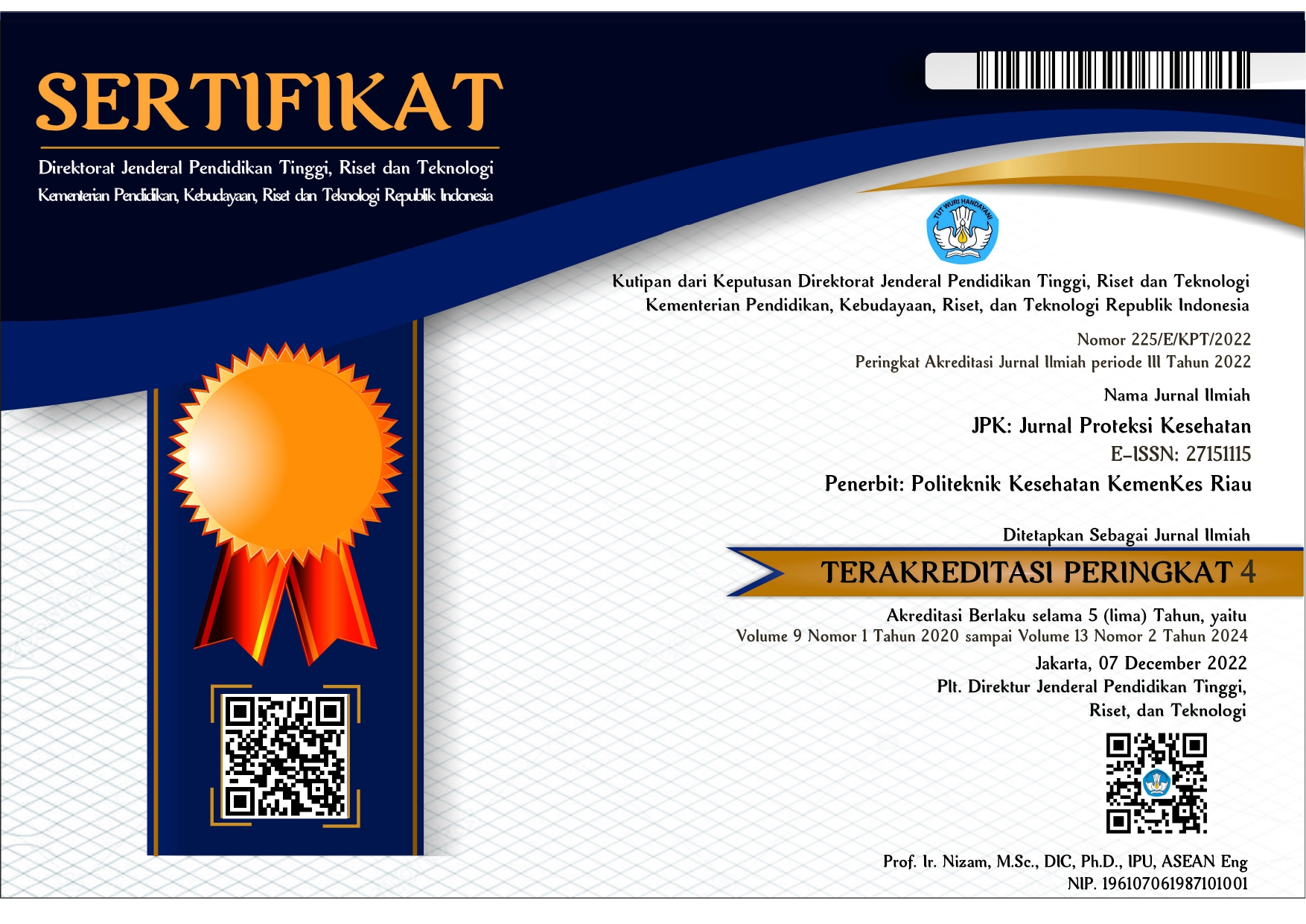Gel Preparation Using Matoa Leaf (Pometia pinnata) Ethanol Extract: Formulation and Physical Evaluation
Abstract
Matoa leaves (Pometia pinnata) contain antioxidants that can prevent premature aging due to free radical damage to skin cells, reduce dark spots, acne, and improve collagen performance in the skin. The gel preparation was chosen because it provides a feeling of coolness, moisture, and good absorption on the skin and is easily washed off with water. The purpose of this research is to create a gel formula and conduct a physical evaluation of the ethanol extract of matoa leaf gel. This study employed an experimental method in which gel preparations were made from ethanol extract of matoa leaves at concentrations of 2%, 3%, and 4%. The organoleptic test results are thick, clear, light green, dark green, and dense dark green, with a distinct smell of ethanol extract of matoa leaves. F0, F1, F2, and F3 all pass the homogeneity test. The pH test results for F0, F1, F2, and F3 are 4-5. F0, F1, F2, and F3 dispersion tests were 6.1 cm, 5.3 cm, 5.7 cm, and 5.5 cm, respectively. As a result, the ethanolic extract of matoa leaves can be formulated as a gel preparation with favorable physical results.
References
[2] Rahimah, E. Sayekti, and A. Jayuska, “Karakterisasi Senyawa Flavonoid Hasil Isolat Dari Fraksi Etil Asetat,” Jkk, vol. 2, no. 2, pp. 84–89, 2013.
[3] N. W. Martiningsih et al., “Skrining Fitokimia Dan Uji Aktivitas Antioksidan Ekstrak Etanol Daun Matoa (Pometia pinnata) dengan Metode DPPH,” J. Ocul. Pharmacol. Ther., vol. 3, no. 3, pp. 332–338, 2016.
[4] F. Maryam, B. Taebe, and D. P. Toding, “Pengukuran Parameter Spesifik Dan Non Spesifik Ekstrak Etanol Daun Matoa (Pometia pinnata J.R & G.Forst),” J. Mandala Pharmacon Indones., vol. 6, no. 01, pp. 1–12, 2020, doi: 10.35311/jmpi.v6i01.39.
[5] H. Kuspradini, W. Fiernaleonardo Pasedan, and I. Wijaya Kusuma, “Aktivitas Antioksidan dan Antibakteri Ekstrak Daun Pometia pinnata,” J. Jamu Indonesia., vol. 1, no. 1, pp. 26–34, 2016, doi: 10.29244/jjidn.v1i1.30593.
[6] W. M. Sidoretno, “Potential of the Ethanolic Extract of Matoa Leaves (Pometia pinnata J.R. & G.Forst) against Staphylococcus aureus bacteria,” JPK J. Prot. Kesehat., vol. 10, no. 2, pp. 107–112, 2022, doi: 10.36929/jpk.v10i2.402.
[7] E. Tahalele, “Formulasi Sediaan Kosmetik Krim Dari Ekstrak Daun Matoa (Pometia Pinnata ) Dan Uji Aktivitas Antioksidan Formulation Cream Cosmetic Preparations Of Matoa (Pometia pinnata) Leaf Extract And Test Activity Antioxidant,” Indones. Nat. Res. Pharm. J., vol. 3, no. 2, pp. 2502–8421, 2018.
[8] Kemenkes RI, Farmakope Indonesia edisi VI, 2020.
[9] C. Bhuyan, D. Saha, and B. Rabha, “A Brief Review on Topical Gels as Drug Delivery System,” J. Pharm. Res. Int., vol. 33, pp. 344–357, 2021, doi: 10.9734/jpri/2021/v33i47a33020.
[10] A. Courtney, “Formularies,” Pocket Handb. Nonhum. Primate Clin. Med., pp. 213–218, 2012, doi: 10.1201/b12934-13.
[11] I. Olivia Borman and E. Sulastri, “Gel Anti Jerawat Ekstrak Daun Buta-Buta (Excoecaria Agallocha L.) Dan Pengujian Antibakteri Staphylococcus Epidermidis Anti-Acne Gel Formulation Of Buta-Buta (Excoecaria Agallocha L.) Leaf Extract And Antibacterial Test Against Staphylococcus epidermidis,” Galen. J. Pharm., vol. 1, no. 2, pp. 65–72, 2015.
[12] S. Titaley, Fatimawali, and W. A. Lolo, “Formulasi dan Uji Efektivitas Sediaan Gel Ekstrak Etanol Daun Mangrove Api-api ( Avicennia marina ),” Pharmacon J. Ilm. Farm. – UNSRAT J. Ilm. Farm., vol. 3, no. 2, pp. 99–106, 2014.
[13] A. P. Juwita, P. V. . Yamlean, and H. J. Edy, “Formulasi Krim Ekstrak Etanol Daun Lamun (Syringodium isoetifolium),” J. Ilm. Farm., vol. 2, no. 02, pp. 8–12, 2013.
[14] I. Y. Astuti, D. Hartanti, and A. Aminiati, “Peningkatan Aktivitas Antijamur Candida Albicans Salep Enhancing Antifungal C Andida Albicans Activity Of Piper Bettle Linn . Leaf Essential Oil Ointment Through Formation Of Complex With-,” Majalah. Obat Tradisional., vol. 15, no. 3, pp. 94–99, 2011.
[15] P. . Patil, S. . Datir, and R. . Saudagar, “A Review on Topical Gels as Drug Delivery System,” J. Drug Deliv. Ther., vol. 9, no. 3, pp. 661–668, 2019, http://dx.doi.org/10.22270/jddt.v9i3.2678
[16] R. Aiyalu, A. Govindarjan, and A. Ramasamy, “Formulation and evaluation of topical herbal gel for the treatment of arthritis in animal model,” Brazilian J. Pharm. Sci., vol. 52, no. 3, pp. 493–507, 2016, doi: 10.1590/s1984-82502016000300015.
[17] Sayuti N, “Formulasi dan Uji Stabilitas Fisik Sediaan Gel Ekstrak Daun Ketepeng Cina (Cassia alata L.),” Jurnal Kefarmasian Indonesia., vol. 5, no. 2, pp. 74–82, 2015.
[18] N. Lumentut, H. J. Edi, and E. M. Rumondor, “Formulasi dan Uji Stabilitas Fisik Sediaan Krim Ekstrak Etanol Kulit Buah Pisang Goroho (Musa acuminafe L.) Konsentrasi 12.5% Sebagai Tabir Surya,” Jurnal MIPA, vol. 9, no. 2, p. 42, 2020, doi: 10.35799/jmuo.9.2.2020.28248.
[19] Tranggono and Latifah, Buku Pegangan Ilmu Pengetahuan Kosmetika. Jakarta: PT. Gramedia Pustaka Utama, 2007.
[20] T. Mappa, H. J. Edy, and N. Kojong, “Formulasi Gel Ekstrak Daun Sasaladahan (Peperomia Pellucida (L.) H.B.K) Dan Uji Efektivitasnya Terhadap Luka Bakar Pada Kelinci (Oryctolagus Cuniculus),” Pharmacon, vol. 2, no. 2, pp. 49–56, 2013.
[21] N. SK, Handbook of Pharmaceutical Manufacturing Formulations: Semisolid Products. Florida: CRC Press LLC, 2004.












